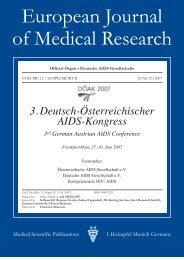alpha-1-antitrypsin deficiency in children: liver disease is not ...
alpha-1-antitrypsin deficiency in children: liver disease is not ...
alpha-1-antitrypsin deficiency in children: liver disease is not ...
- No tags were found...
You also want an ePaper? Increase the reach of your titles
YUMPU automatically turns print PDFs into web optimized ePapers that Google loves.
510 EUROPEAN JOURNAL OF MEDICAL RESEARCHDecember 7, 2005about the r<strong>is</strong>k and the outcome of <strong>liver</strong> <strong>d<strong>is</strong>ease</strong> for the<strong>in</strong>dividual patient.On the bas<strong>is</strong> of these observations we hypothesized:Determ<strong>in</strong>ation of total serum α1-AT <strong>in</strong> the diagnosticworkup of neonatal cholestas<strong>is</strong> <strong>is</strong> an <strong>in</strong>sufficienttool of detect<strong>in</strong>g α1-<strong>antitryps<strong>in</strong></strong> <strong>deficiency</strong> andrare variants of the prote<strong>in</strong>.Detection of rare variants of α1-AT co<strong>in</strong>cid<strong>in</strong>g with<strong>liver</strong> <strong>d<strong>is</strong>ease</strong> can only be detected by determ<strong>in</strong>ation ofthe α1-AT phe<strong>not</strong>ype us<strong>in</strong>g <strong>is</strong>oelectric focus<strong>in</strong>g.We, therefore, reevaluated 48 <strong>children</strong> with differenttypes of α1-AT <strong>deficiency</strong> <strong>in</strong>clud<strong>in</strong>g total serum α1-AT, α1-AT phe<strong>not</strong>ype, appearance of <strong>liver</strong> <strong>d<strong>is</strong>ease</strong> bymeasur<strong>in</strong>g serum levels of AST, ALT, γGT, GLDH,bilirub<strong>in</strong>, and coagulation time at the time of diagnos<strong>is</strong>and after an observation period of 1-18 years (mean 2years).PATIENTS AND METHODSOur study <strong>in</strong>cluded 48 pediatric patients, 27 girls and21 boys, aged between 1 week and 16 years at the timeof diagnos<strong>is</strong> of α1-<strong>antitryps<strong>in</strong></strong> <strong>deficiency</strong>. Diagnos<strong>is</strong> ofα1-<strong>antitryps<strong>in</strong></strong> <strong>deficiency</strong> was proven by <strong>is</strong>oelectric focus<strong>in</strong>g(IEF) of the prote<strong>in</strong> <strong>in</strong> all patients. Analys<strong>is</strong> ofα1-<strong>antitryps<strong>in</strong></strong> was performed <strong>in</strong> serum samples byus<strong>in</strong>g the IEF technique followed by immunopr<strong>in</strong>t<strong>in</strong>g[15, 22]. Patients were grouped <strong>in</strong>to three subsets:patients homozygous for α1-<strong>antitryps<strong>in</strong></strong> <strong>deficiency</strong>(PiZ, PiM Palermo ), patients heterozygous for α1-<strong>antitryps<strong>in</strong></strong><strong>deficiency</strong> (PiMZ, PiMS, PiSZ, PiMP, PiVZ,PiMM procida , PiMQ0), and a patient with a normal rarevariant of the prote<strong>in</strong> (PiMP donauwörth ).We retrospectively analyzed the prevalence of <strong>liver</strong><strong>d<strong>is</strong>ease</strong> <strong>in</strong> each group at the time of diagnos<strong>is</strong>. Liver<strong>d<strong>is</strong>ease</strong> was def<strong>in</strong>ed as evidence of pathological <strong>liver</strong>function tests. Pathological elevation of transam<strong>in</strong>ases(ALT > 40 U/l, AST > 45 U/l) and/or elevation ofγGT (newborn: γGT >120 U/l, <strong>in</strong>fants and <strong>children</strong>:γGT > 45 U/l), conjugated bilirub<strong>in</strong> (> 1,5 mg/dl),and alkal<strong>in</strong>e phosphatase (> 350 U/l) were regarded ashepatit<strong>is</strong> or cholestas<strong>is</strong>, respectively. Serum concentrationsof α1-<strong>antitryps<strong>in</strong></strong> were determ<strong>in</strong>ed <strong>in</strong> each <strong>in</strong>dividualpatient. Liver biopsies were performed <strong>in</strong> patientswith pers<strong>is</strong>tent pathological <strong>liver</strong> function testsonly.All patients underwent a cl<strong>in</strong>ical and laboratoryreevaluation after a mean period of 2 years after be<strong>in</strong>gdiagnosed as deficient for α1-<strong>antitryps<strong>in</strong></strong>. Appearanceof <strong>liver</strong> <strong>d<strong>is</strong>ease</strong> was aga<strong>in</strong> def<strong>in</strong>ed by pathological elevationof <strong>liver</strong> function tests as described above.Serum concentrations of α1-<strong>antitryps<strong>in</strong></strong> were measured<strong>in</strong> all patients at the time of reevaluation.We compared the three subsets of patients regard<strong>in</strong>gappearance of <strong>liver</strong> <strong>d<strong>is</strong>ease</strong>, total serum concentrationsof α1-<strong>antitryps<strong>in</strong></strong>, cl<strong>in</strong>ical course of the patients,especially development of cirrhos<strong>is</strong>.Differences between goups were analysed us<strong>in</strong>g theWilcoxon-Rank Sum test.RESULTSAbnormal variants of the α1-<strong>antitryps<strong>in</strong></strong> were detected<strong>in</strong> all patients by <strong>is</strong>oelectric focus<strong>in</strong>g. Analys<strong>is</strong> ofserum α1-<strong>antitryps<strong>in</strong></strong> and <strong>is</strong>oelectric focus<strong>in</strong>g of theprote<strong>in</strong> was performed because of appearance of <strong>liver</strong><strong>d<strong>is</strong>ease</strong> <strong>in</strong> 50 %, cl<strong>in</strong>ical signs of airway obstruction <strong>in</strong>18 %, family h<strong>is</strong>tory of α1-<strong>antitryps<strong>in</strong></strong> <strong>deficiency</strong> <strong>in</strong>10%. In 12% of the patients α1-<strong>antitryps<strong>in</strong></strong> <strong>deficiency</strong>was detected dur<strong>in</strong>g a rout<strong>in</strong>e follow up.Homozygous α1-<strong>antitryps<strong>in</strong></strong> <strong>deficiency</strong> was diagnosed<strong>in</strong> 12 patients (PiZZ), heterozygous α1-<strong>antitryps<strong>in</strong></strong><strong>deficiency</strong> <strong>in</strong> 28 patients (PiMZ n = 17, PiMS n= 7, PiSZ n = 2, PiVZ n = 1, PiMP n = 1), rarevariants of the prote<strong>in</strong> were found <strong>in</strong> 8 patients(PiM(Q0) n = 4, PiMP donauwörth n = 1, PiMM procida n =1, PiM palermo n = 2), respectively. Low serum concentrationsof α1-<strong>antitryps<strong>in</strong></strong> were detected <strong>in</strong> all patientswith homozygous <strong>deficiency</strong>, however 36% of thepatients with heterozygous variants showed normalserum levels of α1-<strong>antitryps<strong>in</strong></strong>. Serum levels of α1-<strong>antitryps<strong>in</strong></strong>ranged between 78 and 100% <strong>in</strong> patients withthe rare variant M(Q0), between 9,5 and 12% <strong>in</strong> patientswith the variant PiM palermo , 10% <strong>in</strong> the phe<strong>not</strong>ypePiMM procida , 100% <strong>in</strong> the patient with the phe<strong>not</strong>ypePiMP donauwörth . Table 1 summarizes the results ofserum α1-<strong>antitryps<strong>in</strong></strong> accord<strong>in</strong>g to the phe<strong>not</strong>ypes.Table 1. Pi phe<strong>not</strong>ypes and serum concentrations of α1-<strong>antitryps<strong>in</strong></strong> <strong>in</strong> 48 pediatric patients with (values of serum α1-<strong>antitryps<strong>in</strong></strong>are given <strong>in</strong> mg/dl (a) and <strong>in</strong> percent of normal values for age (b)*Phe<strong>not</strong>ype Number of patients α1-AT <strong>in</strong> mg/dl α1-AT <strong>in</strong> %± SD of age related to normal valuehomozygous Z 12 34 24 ± 8M palermo 2 19 11 ± 4heterozygous MS 7 125 81 ± 11MZ 17 95 69 ± 9SZ 2 56 40 ± 7MP 1 115 88 ± 0VZ 1 60 46 ± 0MM procida 1 105 81 ± 0M(Q0) 4 190 94 ± 6variant MP donauwörth 1 200 100 ± 0* data are expressed as means.





